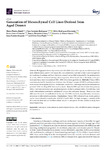Mostrar o rexistro simple do ítem
Generation of mesenchymal cell lines derived from aged donors
| dc.contributor.author | Piñeiro-Ramil, María | |
| dc.contributor.author | Sanjurjo-Rodríguez, Clara | |
| dc.contributor.author | Rodríguez-Fernández, Silvia | |
| dc.contributor.author | Castro Viñuelas, Rocío | |
| dc.contributor.author | Hermida Gómez, Tamara | |
| dc.contributor.author | Blanco García, Francisco J | |
| dc.contributor.author | Fuentes Boquete, Isaac Manuel | |
| dc.contributor.author | Díaz-Prado, Silvia | |
| dc.date.accessioned | 2021-10-15T10:22:25Z | |
| dc.date.available | 2021-10-15T10:22:25Z | |
| dc.date.issued | 2021-10-01 | |
| dc.identifier.citation | Piñeiro-Ramil M, Sanjurjo-Rodríguez C, Rodríguez-Fernández S, Castro-Viñuelas R, Hermida-Gómez T, Blanco-García FJ, Fuentes-Boquete I, Díaz-Prado S. Generation of mesenchymal cell lines derived from aged donors. Int J Mol Sci. 2021 Oct 1;22(19):10667. | es_ES |
| dc.identifier.issn | 1422-0067 | |
| dc.identifier.uri | http://hdl.handle.net/2183/28645 | |
| dc.description.abstract | [Abstract] Background: Mesenchymal stromal cells (MSCs) have the capacity for self-renewal and multi-differentiation, and for this reason they are considered a potential cellular source in regenerative medicine of cartilage and bone. However, research on this field is impaired by the predisposition of primary MSCs to senescence during culture expansion. Therefore, the aim of this study was to generate and characterize immortalized MSC (iMSC) lines from aged donors. Methods: Primary MSCs were immortalized by transduction of simian virus 40 large T antigen (SV40LT) and human telomerase reverse transcriptase (hTERT). Proliferation, senescence, phenotype and multi-differentiation potential of the resulting iMSC lines were analyzed. Results: MSCs proliferate faster than primary MSCs, overcome senescence and are phenotypically similar to primary MSCs. Nevertheless, their multi-differentiation potential is unbalanced towards the osteogenic lineage. There are no clear differences between osteoarthritis (OA) and non-OA iMSCs in terms of proliferation, senescence, phenotype or differentiation potential. Conclusions: Primary MSCs obtained from elderly patients can be immortalized by transduction of SV40LT and hTERT. The high osteogenic potential of iMSCs converts them into an excellent cellular source to take part in in vitro models to study bone tissue engineering. | es_ES |
| dc.description.sponsorship | This research was carried out thanks to the funding from Rede Galega de Terapia Celular 2016 (R2016/036) and Grupos con Potencial de Crecemento 2020 (ED431B 2020/55) from Xunta de Galicia, Proyectos de Investigación 2017 (PI17/02197) from Instituto de Salud Carlos III and the Biomedical Research Network Center (CIBER). The Biomedical Research Network Center (CIBER) is an initiative from Instituto de Salud Carlos III (ISCIII). MPR and SRF were granted a predoctoral fellowship from Xunta de Galicia and European Union (European Social Fund) | es_ES |
| dc.description.sponsorship | Xunta de Galicia; R2016/036 | es_ES |
| dc.description.sponsorship | Xunta de Galicia; ED431B 2020/55 | es_ES |
| dc.description.sponsorship | info:eu-repo/grantAgreement/MINECO/Plan Estatal de Investigación Científica y Técnica y de Innovación 2017-2020/PI17%2F02197/ES/Células madre pluripotentes inducidas (iPS) como modelo de artrosis de manos | |
| dc.language.iso | eng | es_ES |
| dc.publisher | MDPI | es_ES |
| dc.relation.uri | https://doi.org/10.3390/ijms221910667 | es_ES |
| dc.rights | Creative Commons Attribution 4.0 International Licence (CC-BY 4.0) | es_ES |
| dc.rights.uri | http://creativecommons.org/licenses/by/4.0/ | * |
| dc.subject | Bone repair | es_ES |
| dc.subject | Immortalization | es_ES |
| dc.subject | Mesenchymal stromal cells | es_ES |
| dc.subject | Cell differentiation | es_ES |
| dc.subject | Osteogenesis | es_ES |
| dc.subject | Senescence | es_ES |
| dc.title | Generation of mesenchymal cell lines derived from aged donors | es_ES |
| dc.type | info:eu-repo/semantics/article | es_ES |
| dc.rights.access | info:eu-repo/semantics/openAccess | es_ES |
| UDC.journalTitle | International Journal of Molecular Sciences | es_ES |
| UDC.volume | 22 | es_ES |
| UDC.issue | 19 | es_ES |
| UDC.startPage | 10667 | es_ES |
| dc.identifier.doi | 10.3390/ijms221910667 |
Ficheiros no ítem
Este ítem aparece na(s) seguinte(s) colección(s)
-
GI-TCMR - Artigos [131]
-
INIBIC-TCMR - Artigos [102]
-
INIBIC- REUMA - Artigos [184]






